
| ICE Case Studies
|
South Ossetian Separatism in Georgia by Rebecca Ratliff |
I.
Case Background |

The South Ossetians of Georgia have been in conflict with the Georgian government since just before the dissolution of the Soviet Union in the early 1990’s. Between 1918 and 1920, the first overtures to South Ossetian independence were made during a series of Ossetian rebellions against the first Georgian Republic. Once Georgia came under Soviet rule in 1923, and for the remainder of Soviet rule, there was peace between the two groups. Major violent conflict erupted again, however, between Ossetian separatist guerillas and Georgian troops in the early 1990’s, and then once more in 2004. The basic domestic and international issues surrounding the conflict are the South Ossetians' claims of unequal treatment under Georgian rule and subsequent demands for cultural, social, economic and political protections as a minority group, Russia’s desire to punish Georgia for its increasingly pro-Western political orientation, and outside concerns about the stability and accessibility of the Baku-Tbilisi-Ceyhan pipeline running partly through Georgia. However, at the conflict’s most basic level, it is a conflict over land and territory. Georgia wants to maintain its territorial integrity and thus prevent the region of South Ossetia from seceding, while South Ossetia wants to either establish independence or join with North Ossetia and come under Russian rule.
In essence, my research will consider the history of relations between the Georgians, Russians and Ossetians, the ethnic/cultural differences, the current interests/motivations of all sides, and the prospects for settling the dispute over the land.
Read about the related case of Nagorno-Karabakh
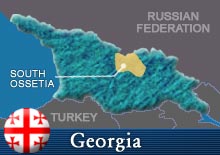 The
region of South Ossetia lies in the north central part of Georgia and is home
to an ethnic group distinct from both the Georgians and Russians. When Georgia
came under Soviet rule in 1923, the Soviet government granted South Ossetia
the status of being the South Ossetian Autonomous Oblast (SOAO) within the Soviet
Republic of Georgia. At the same time, North Ossetia was left under the domain
of Russia, thus splitting Ossetia into Northern and Southern regions. Therefore,
since the break-up of the Soviet Union, the South Ossetians, have been attempting
to gain independence since November 1989 when the SOAO Council sent a letter
to the Georgian Supreme Soviet demanding to be unified with North Ossetia, mostly
out of concern regarding Georgian nationalism and subsequent second class treatment.
The Georgian leaders did not meet the demands of the South Ossetians and went
so far as to ban all regional political parties in September 1990 during parliamentary
elections. The Ossetians interpreted this as a move directly intended to weaken
South Ossetian autonomy and power in the political system. Therefore, Soviet
leaders approved of unification with North Ossetia, located in Russia, but Georgian
leaders did not. This triggered a series of events which eventually led to violent
conflict between the South Ossetians and Georgia. In September 1990, the Ossetians
declared sovereingty under the USSR and in return, the Georgian government dissolved
its recognition of the South Ossetian Autonomous Oblast. In January 1992, a
referendum was held in Tskhinvali, the regional capital of South Ossetia, with
a clear majority of the people supporting South Ossetia's seccession from Georgia
and joining Russia. The South Ossetian Supreme Council made these desires official
after voting in favor of secession from Georgia to Russia on November 19, 1992.
(10)
The
region of South Ossetia lies in the north central part of Georgia and is home
to an ethnic group distinct from both the Georgians and Russians. When Georgia
came under Soviet rule in 1923, the Soviet government granted South Ossetia
the status of being the South Ossetian Autonomous Oblast (SOAO) within the Soviet
Republic of Georgia. At the same time, North Ossetia was left under the domain
of Russia, thus splitting Ossetia into Northern and Southern regions. Therefore,
since the break-up of the Soviet Union, the South Ossetians, have been attempting
to gain independence since November 1989 when the SOAO Council sent a letter
to the Georgian Supreme Soviet demanding to be unified with North Ossetia, mostly
out of concern regarding Georgian nationalism and subsequent second class treatment.
The Georgian leaders did not meet the demands of the South Ossetians and went
so far as to ban all regional political parties in September 1990 during parliamentary
elections. The Ossetians interpreted this as a move directly intended to weaken
South Ossetian autonomy and power in the political system. Therefore, Soviet
leaders approved of unification with North Ossetia, located in Russia, but Georgian
leaders did not. This triggered a series of events which eventually led to violent
conflict between the South Ossetians and Georgia. In September 1990, the Ossetians
declared sovereingty under the USSR and in return, the Georgian government dissolved
its recognition of the South Ossetian Autonomous Oblast. In January 1992, a
referendum was held in Tskhinvali, the regional capital of South Ossetia, with
a clear majority of the people supporting South Ossetia's seccession from Georgia
and joining Russia. The South Ossetian Supreme Council made these desires official
after voting in favor of secession from Georgia to Russia on November 19, 1992.
(10)
Under Soviet rule, there was little conflict between the two groups as everything was administered for both of them from one central authority in Moscow. However, as the Soviet Union began to rapidly decline in the late 1980’s, Georgian nationalism swelled and made the Ossetians living under the Georgian jurisdiction very nervous. Therefore, when the Georgians refused to recognize or allow South Ossetia to unite with North Ossetia and join Russia proper in 1989, violence began to simmer and eventually broke out in 1991, when thousands of Georgian troops marched on Tskhinvali and many Ossetian villages and Georgian homes were attacked by each opposing side. The fighting escalated in the spring of 1992, which included some Russian involvement in the conflict as well. A ceasefire was negotiated in 1992 between then Russian President Boris Yeltsin and then Georgian President Eduard Shevardnadze and a Joint Control Commission was established as a peacekeeping force comprised of Russian, Georgian, and Ossetian troops. At the conclusion of the fighting in 1992, it is estimated there were 1,000 wartime casualties, 100 missing persons, and an innumerable amount of damaged or destroyed homes and infrastructure.(10) However, in 2004, violence began once again when Georgia tried to clamp down on Russian activity in South Ossetia. In July 2004, the Russian Duma passed a resolution proclaiming its support of the South Ossetians in the conflict with Georgia.
Who Are the Ossetians?
The Ossetians are spread across several countries including Russia, Georgia, Azerbaijan, Turkey and others. However, the home base is Ossetia itself which is also divided between countries; the north in Russia and the south in Georgia. The goal of the South Ossetian separatists is to either gain its independence or unite with North Ossetia, which lies in Russia.
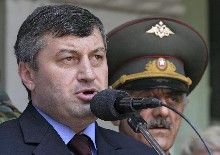 Ethnically,
the Ossetians are of Iranian stock and speak their own language, which is closely
related to Pashto, and more distantly to Farsi. They claim to be the descendents
of the ancient Alanian and Scythian tribes and therefore to have been inhabiting
the South Caucasus for thousands of years. The Georgians, on the other hand,
are a Caucasian people and speak a language belonging to the Caucasian family.
The Georgians also claim to have ancient roots in the South Caucasus, while
at the same time arguing that the Ossetians only migrated to the Caucasus between
the 17th and 19th centuries. Along religious lines, both are predominately Orthodox
Christian, with a Sunni Islam minority among the Ossetians. Therefore, the conflict
between the two peoples is not based on religion, but rather on ethnicity, and
territory.(10)
Ethnically,
the Ossetians are of Iranian stock and speak their own language, which is closely
related to Pashto, and more distantly to Farsi. They claim to be the descendents
of the ancient Alanian and Scythian tribes and therefore to have been inhabiting
the South Caucasus for thousands of years. The Georgians, on the other hand,
are a Caucasian people and speak a language belonging to the Caucasian family.
The Georgians also claim to have ancient roots in the South Caucasus, while
at the same time arguing that the Ossetians only migrated to the Caucasus between
the 17th and 19th centuries. Along religious lines, both are predominately Orthodox
Christian, with a Sunni Islam minority among the Ossetians. Therefore, the conflict
between the two peoples is not based on religion, but rather on ethnicity, and
territory.(10)
After the break-up of the Soviet Union and the creation of the new independent state of Georgia, the South Ossetians have felt oppressed and threatened by Georgian domestic policies. For example, Georgian was made the official administrative language throughout the state, but the Ossetians wanted their own language to be official in the South Ossetia region.
3. Duration
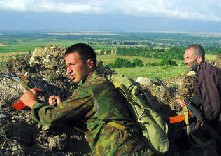 The
conflict began with the fall of the Soviet Union in the early 1990's, when the
South Ossetians saw the dismantling of the Soviet Empire as an opportunity to
establish their independence from Georgia. In 1991, violent conflict broke out
between Georgian and South Ossetian forces resulting in hundreds of thousands
being killed, displaced, or injured on both sides. In 1992 a peace deal was
struck with the aid of Russia and a peacekeeping force comprised of Russian,
Georgian, North and South Ossetians was formed to maintain peace among the population
groups. The peace was relatively stable and lasted until 2004, when violent
conflict again broke out as a result of the Georgian government's attempt to
close down the significant black market trade going on between South Ossetia
and Russia. The violence has again subsided, however the conflict is far from
solved.
The
conflict began with the fall of the Soviet Union in the early 1990's, when the
South Ossetians saw the dismantling of the Soviet Empire as an opportunity to
establish their independence from Georgia. In 1991, violent conflict broke out
between Georgian and South Ossetian forces resulting in hundreds of thousands
being killed, displaced, or injured on both sides. In 1992 a peace deal was
struck with the aid of Russia and a peacekeeping force comprised of Russian,
Georgian, North and South Ossetians was formed to maintain peace among the population
groups. The peace was relatively stable and lasted until 2004, when violent
conflict again broke out as a result of the Georgian government's attempt to
close down the significant black market trade going on between South Ossetia
and Russia. The violence has again subsided, however the conflict is far from
solved.
The location of most of the fighting has been within the South Ossetian territory itself. However, the effects of the conflict have spread to other areas of Georgia and into Russia as people have become refugees and moved between Georgia, Russia and South Ossetia. During the fighting in 1991, Tskhinvali, the capital of South Ossetia, and a 15 kilometer area around the city were officially declared as the zone of conflict.(10)
1. Georgia
2. South Ossetia
3. Russia
4. North Ossetia

This is a map of the different environmental issues facing Georgia.
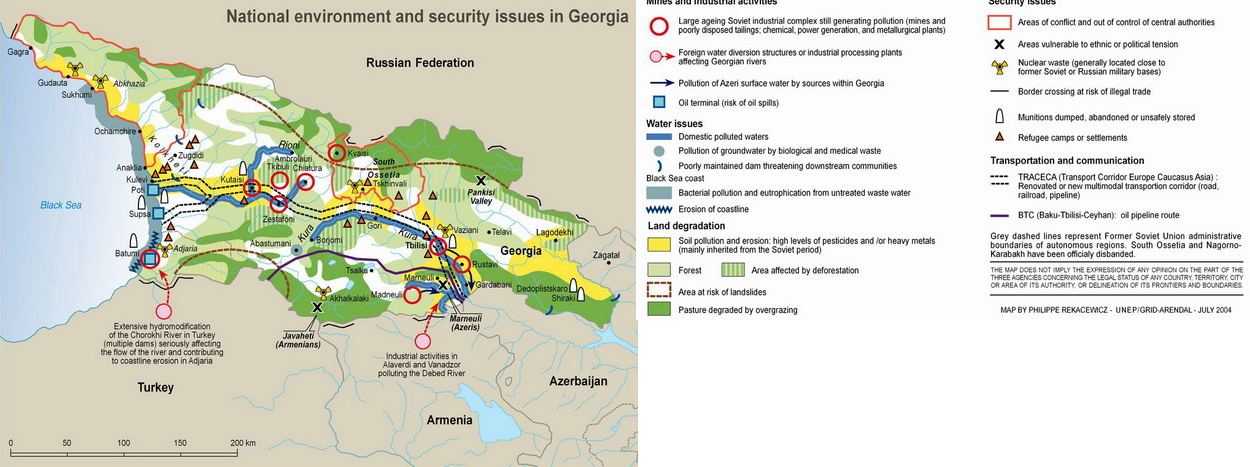
The conflict between Georgia and the ethnic Ossetians is a dispute over territory, as the South Ossetians want to break away from Georgia, but Georgia wants to keep South Ossetia under its rule. However, there is more to the story than just territory and ethnic divisions. The environmental aspects of the dispute are also an important part of the picture. According to a Pro-Natura Proposal, “The long-lasting conflict in South Ossetia has had a significant impact on the environment, including the degradation, depletion and mismanagement of natural resources.”(11) In addition, the territory of South Ossetia, located in north central Georgia, holds two of the four major border crossings among the mountains separating Russia and Georgia and has several of Georgia’s important roadways running through it from east to west and north to south. Retaining control over such roadways and border crossings is important for Georgia as they aid both inter and intra-state movement of people and goods. In addition, two important oil pipelines, the Baku-Tbilisi-Ceyhan and Baku-Supsa (see map), run through Georgia on their way to Black Sea ports. Separatist movements, such as the South Ossetian movement, pose security threats to the pipelines and the flow of energy sources. (16) So not only is the environmental aspect important in terms of pollution and degradation, but also in geo-political strategic terms as well.
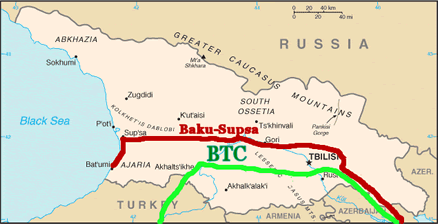 Conflict
with South Ossetia and also Abkhazia, make it very difficult for Georgia, or
anyone else, to address environmental issues and establishing peace with conflict
areas like South Ossetia may be nearly impossible without considering the environmental
factors involved. For example, a 2004 report by the United Nations Environment
Programme says, “Environmental degradation and the use of natural resources
are identified as factors that could deepen contention in areas of existing
conflicts as in Abkhazia, South Ossetia…”.(12) Acquiring accurate
data about the environmental situation in South Ossetia is very difficult, which
is a problem in of itself, however problems such as the exploitation of natural
resources and soil contamination are known to exist in South Ossetia. Unfortunately,
many environmental challenges were also inherited by Georgia after the collapse
of the Soviet Union, such as hazardous waste dumps, aging nuclear sites, etc.
For example, there is an old Soviet “industrial complex” in northwest South
Ossetia that is categorized as “still generating pollution” and a nuclear waste
site in the south part of the territory, also leftover from the days of Soviet
rule. Again, with the territory in conflict, these environmental hazards are
not being properly secured, monitored, or cleaned up. This is obviously a major
risk to the local population as water supplies and arable land can be severely
damaged by pollution from these sites. A decrease in access to clean water and
arable land could only worsen the conflict, as a fight for control of these
resources could inflame the fighting.
Conflict
with South Ossetia and also Abkhazia, make it very difficult for Georgia, or
anyone else, to address environmental issues and establishing peace with conflict
areas like South Ossetia may be nearly impossible without considering the environmental
factors involved. For example, a 2004 report by the United Nations Environment
Programme says, “Environmental degradation and the use of natural resources
are identified as factors that could deepen contention in areas of existing
conflicts as in Abkhazia, South Ossetia…”.(12) Acquiring accurate
data about the environmental situation in South Ossetia is very difficult, which
is a problem in of itself, however problems such as the exploitation of natural
resources and soil contamination are known to exist in South Ossetia. Unfortunately,
many environmental challenges were also inherited by Georgia after the collapse
of the Soviet Union, such as hazardous waste dumps, aging nuclear sites, etc.
For example, there is an old Soviet “industrial complex” in northwest South
Ossetia that is categorized as “still generating pollution” and a nuclear waste
site in the south part of the territory, also leftover from the days of Soviet
rule. Again, with the territory in conflict, these environmental hazards are
not being properly secured, monitored, or cleaned up. This is obviously a major
risk to the local population as water supplies and arable land can be severely
damaged by pollution from these sites. A decrease in access to clean water and
arable land could only worsen the conflict, as a fight for control of these
resources could inflame the fighting.
Deforestation has also become a problem in South Ossetia as a result
of the conflict. Areas on the eastern and western edges of South Ossetia have
experienced significant loss of forests and as the area is now without the state’s
control, it is hard to both monitor and assess the situation. However, according
to the UNEP report, the deforestation can be attributed to an energy crisis
in rural areas and, “Incentives for illegal exports of valuable timber and endemic
tree species from the conflict areas of Georgia…".(12) Overgrazing
of pasture lands in the northern part of South Ossetia has also become a problem.
South Ossetia is somewhat isolated with a weak economy that relies mainly on
smuggling goods across the border with Russia. In 2004, the Georgian government
began to crackdown hard on the smuggling and black-market activities in South
Ossetia, which drove monthly earnings even lower than they already were.(13)
Therefore, the economic plight of South Ossetia most definitely contributes
to the degradation of the environment and to deforestation in particular.
The natural environment of Georgia and in particular, South Ossetia is mountainous with a temperate climate.

The conflict between the region of South Ossetia and Georgia is civil in nature. The fighting has taken place in Georgia between different factions of the population and not between two separate states.
It is an intrastate conflict and is currently at a low threat level. Between 1991 and 1992, the violence was more severe, but then felll quiet throughout the 90’s and into the early 2000’s after a cease-fire agreement was signed between Georgia and Russia in June 1992.. In 2004, violence began to erupt again with shelling and gun battles taking place between the Georgian military and South Ossetian rebels. During this time, there were both military and civilian casualties, but again the violence died down with the signing of a cease-fire agreement in August 2004.(14)
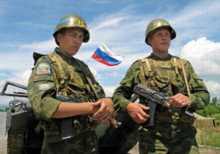 June
8, 1992 is the date when the conflict officially reached the 25 mark for military
casualties, but in reality, the fighting between 1991 and 1992 led to over 1,000
civilian and military deaths. During the violence in 2004, at least 22 people
died as a result of the armed conflict. When looking at the numbers for displaced
peoples, the numbers are significantly higher than actual casualties. For example,
from the US Library of Congress country study on Georgia, it says, “The resulting
conflict lasted throughout 1991, causing thousands of casualties and creating
tens of thousands of refugees on both sides of the Georgian-Russian border.”(15)
The exact numbers for casualties are a bit hard to find, especially related
to civilians. However, it is certain thousands of deaths have occurred during
the particularly violent periods in the early 1990’s and in 2004, but for now
the violence, but not the threat of violence has subsided.
June
8, 1992 is the date when the conflict officially reached the 25 mark for military
casualties, but in reality, the fighting between 1991 and 1992 led to over 1,000
civilian and military deaths. During the violence in 2004, at least 22 people
died as a result of the armed conflict. When looking at the numbers for displaced
peoples, the numbers are significantly higher than actual casualties. For example,
from the US Library of Congress country study on Georgia, it says, “The resulting
conflict lasted throughout 1991, causing thousands of casualties and creating
tens of thousands of refugees on both sides of the Georgian-Russian border.”(15)
The exact numbers for casualties are a bit hard to find, especially related
to civilians. However, it is certain thousands of deaths have occurred during
the particularly violent periods in the early 1990’s and in 2004, but for now
the violence, but not the threat of violence has subsided.

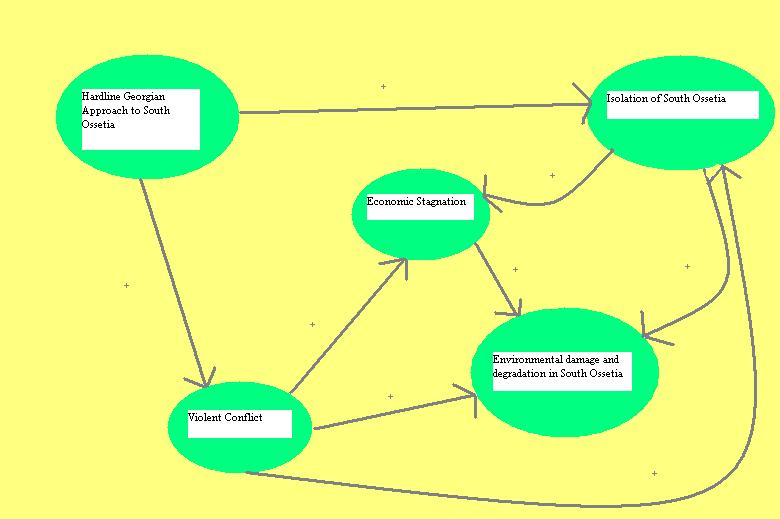
Above is a causal diagram showing the links between conflict, the environment, economy and political situation in Georgia/South Ossetia.
The relationship between conflict and environment in the case of Georgia-South
Ossetia dispute is indirect. The conflict is over control of the region of South
Ossetia, but has more to do with ethnic tensions and political gain than environmental
resources. However, the conflict has had a negative impact on the environment
with issues of deforestation, soil degradation, and pollution from unmanaged
hazardous waste sites becoming a problem throughout Georgia and the South Ossetia
region in particular.
The conflict between Georgia and South Ossetia is state v. sub-state. South Ossetia is a region in the north of Georgia, which is trying to either establish its independence or secede from Georgia and join Russia. Therefore, the conflict is within one state; Georgia.
Currently the Georgia-South Ossetia conflict is a stalemate. The South Ossetians still desire to breakaway from Georgia and establish their own state, and likewise, Georgia still wants to retain its territorial integrity and keep the region of South Ossetia as a part of the state. Violence first erupted in 1991 and then again in 2004, and although the situation is not violent at the moment, the threat of violent conflict remains.

The Nagorno-Karabakh case pertains to the current territorial dispute between Azerbaijan and Armenia over the region of Nagorno-Karabakh. Both countries claim the territory, however the population is mostly composed of ethnic Armenians. Like the conflict between the Georgians and South Ossetians, this too erupted just after the break up of the Soviet Union.
The Kashmir case deals with the disputed region in northern India, which both India and Pakistan claim as their own. Violence has occurred there and is related to the South Ossetian case as it is a territorial conflict.
The conflict in Chechnya is also an ethnic/territorial conflict taking place in the Caucasus.
Kirkuk is a city in northern Iraq. This conflict also deals with ethnic divides and claims on territory.
1. Lynch, Dov, Engaging Eurasia’s Separatist States : Unresolved
Conflicts and de facto States
2. Alexei Arbatov [et al], Managing conflict in the former Soviet Union
: Russian and American perspectives
3. Coppieters, Bruno, Federalism and conflict in the Caucasus
4. Corso, Molly, “SHELLING SHATTERS CHANCES FOR GEORGIA-SOUTH OSSETIA
PEACE?” http://www.eurasianet.org/departments/insight/articles/eav092305a.shtml
5. Simakovsky, Mark David, “US DIPLOMACY STRIVES TO KEEP SOUTH OSSETIA
CONFLICT IN CHECK” http://www.eurasianet.org/departments/insight/articles/eav093005a.shtml
6. Freese, Theresa, “TENSION AGAIN ON THE RISE IN SOUTH OSSETIA”
http://www.eurasianet.org/departments/insight/articles/eav072905.shtml
7. Many articles on www.eurasia.net
8. Welt, Cory, “Balancing the Balancer: Russia, the West, and Conflict
Resolution in Georgia” http://www.csis.org/component/option,com_csis_pubs/task,view/id,2675/
9. http://ossetians.com/eng
10. International Crisis Group, Georgia: Avoiding War in South Ossetia, 26 November 2004
11. Pro-Natura USA, “Caucasus Peace Park, a Feasibility Study for Georgia and Russia”, Project Summary, September 2005, Article
12. UNEP, "Environment and Security-Transforming Risks into Cooperation the Case of the Southern Caucasus", 2004 Article
13. Freese, Theresa, “Story: Smuggling to Survive”, Article
14. Department of Peace and Conflict Research, Basic Search, Uppsala University Article
15. Georgia, Country Studies, Library of Congress Article
16. Energy Information Administration, Country Analysis Brief,
Caspian Sea http://www.eia.doe.gov/emeu/cabs/Caspian/RegionalConflicts.html
